Notes on Star Hikes
Onteora Scout Reservation
Prepared by Bill Donald
Typed by Doug Donald
A constellation is a group or cluster of stars which is based on a
mythological fantasy. Constellations are figments of man's imagination. They
don't really exist. In fact, constellations were created and used by the
ancients as an aid to map the sky. Of course different constellations with
their own unique mythology were developed by different peoples in far flung
geological areas. The most striking constellations are those of Greek
and Roman origin. Of the 88 constellations commonly used today, many were
mentioned in the writings of Homer and Hesoid. In only a few instances,
constellations resemble actual objects: the Great or Big Dipper of Ursa Major
(the Big Bear), the Northern Cross of Cygnus (the Swan), the Great Squaw of
Pegasus (the Winged Horse), and the Sickle of Leo (the Lion).
On a clear night, Ursa Major can be found by facing North and looking for
a Big Dipper. Besides being called the Big Bear or the Big Dipper in the U.S., Ursa Major is known as the plow or the Wagon
in Britain. In actuality, the Big Dipper is only one fourth of the entire
constellation, which is made up of fainter stars. Mizor and Alcor, double
stars, can be found in the handle of the Dipper. Supposedly they were used as an eyesight test
in the Army, and the
French Foreign Legion before 1940.
| The Big and Little Bear place prominently in
the legends of
the American Indian tribes. Manitu supposedly put the Bear constellations
into the skies to tell bears when to go into hibernation When these constellations reach a certain position in the night skies around Polaris
(which represents their cave), all bears would know when to go Into hibernation . |
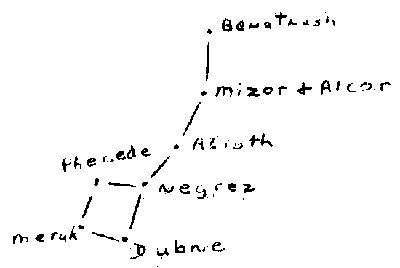 |
| An Iroquois legend relates that once a Great Bear ravaged
their village. For many winter months, this beast had prevented the braves
from hunting and thus had left the village facing destitution and famine.
Then, on a clear, crisp night, the three sons of the village
chiefs had the same dream: they would slay the Great Bear. Embarking on
this task the following day, the three chased the Great Bear to the four
corners of the Earth, which the Indians thought was shaped like a giant
tortoise shell. Finally the bear ,jumped off followed by the three braves.
Consequently the four stars in the bowl of the Big Dipper represent the
Great Bear and the three in the handle represent the Indian braves. |
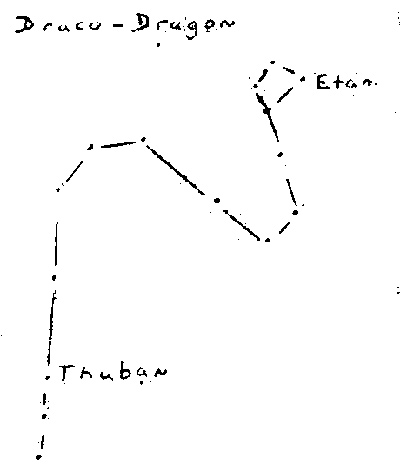 |
|
As a circumpolar constellation, Ursa Major is an important
guide to other groups of stars. Ursa Minor (the Little Bear or Little Dipper) is
also a circumpolar constellation which resembles an old-style cream ladle or
gravy spoon. At the tip of the handle of Ursa Minor, you can find Polaris.
Polaris, the North Star, is almost 50 light years away. Contrary to common opinion, Polaris
is not directly centered on the Earth's axis. However, it's only half a degree off true north.
Moreover, the North Star is commonly used by navigators , to determine direction. The outer
stars in the bowl of Ursa Minor are often referred to as the guardians of the
pole or simply, the guards.
Ursa Minor also has a place in Indian legends. The Indian thought
that the Little Bear's tail was too long for any self-respecting bear. It was said that Manitu
placed the Little Bear in the
sky slung by its tail. As time passed, its tail stretched.
|
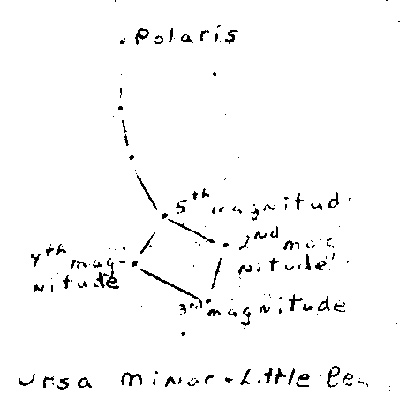 |
|
Draco, the dragon, is another circumpolar constellation.
Consisting of over 80 stars, this constellation curves between the two dippers
and ends as a group of four stars which form the dragon's head. Thuban, a star near
the tip of
Draco's tail was the pole star used by the Egyptians 4,000 years ago
to orient the pyramids. Surprisingly, Thuban is one of the few Egyptian
named stars which have lasted to our time. Most star names are of Greek or Latin
origin.
Draco is steeped in the legends of ancient
Greece. It was the dragon that Hercules slayed in order to steal the golden
apples in the gardens of the Hesperides.
|
 |
|
No other constellations are
so well illustrated in Greek mythology as
the ones involving Perseus, the king and queen of Ethiopia and their daughter
Andromeda. According to this legend, Cassiopeia, the wife of Cepheus the king of Ethiopia, lived
happily until she dared to compare her own beauty-to that of the Nephrides, the
Sea Nymphs. Insulted, the Nephrides went to Neptune to demand vengeance. The god
of the sea went and sent Cetus (the Sea Monster) to ravage the Ethiopian coast.
To appease the gods and end the ruin of their country. Cassiopeia and Cepheus
would have to chain their daughter Andromeda (the Maid) to a rock on the coast as a
sacrifice to Cetus. Just as the Sea Monster appeared, so did the hero Perseus
(the Son of
Jupiter). He was returning on winged sandals after killing Medusa. Seeing Andromeda in
danger, Perseus
slew Cetus and later married Andromeda. However. the Nephrides
were to be revenged. Neptune later flung Pereseus, Andromeda, Cassiopeia and Cepheus into the sky to remain as constellations for
all eternity.
Cassiopeia is a circumpolar constellation which is also
known as the Lady in the Chair. This group of five stars is shaped
like a stretched out W or an elongated M, representing the Queen of Ethiopia in
her chair. Such a lopsided chair would indeed be a torture for a woman who had
to sit in it for all eternity.
Cepheus, another circumpolar constellation, is quite near Cassiopeia in the heavens. At one corner
of this house shaped constellation is a group of three
stars known as Delta. Cephei, the first variable star to be
discovered, was found in Cepheus. This variable star changes in magnitude every
5 and 1/3rd days.
Lyra (the Lyre or Harp) is an important circumpolar
constellation because it contains Vega, the 4th brightest star in the heavens,
and is situated about 24 light years away from the earth. Just as stars change
in relation to the earth, Thuban was replaced by Polaris as the North star. In
several thousand years it is calculated that Vega will replace Polaris.
Early Greek mythology pictured Lyra as being an eagle, vulture or a tortoise.
This description was based on the legend that Mercury (the Messenger
of the gods) invented the first lyre by placing several strings across the back
of a tortoise shell. In its most primitive form the Lyre has three or four strings. In its most complex state, there are up to
16. In addition, the Lyre was the symbol of Apollo.
|
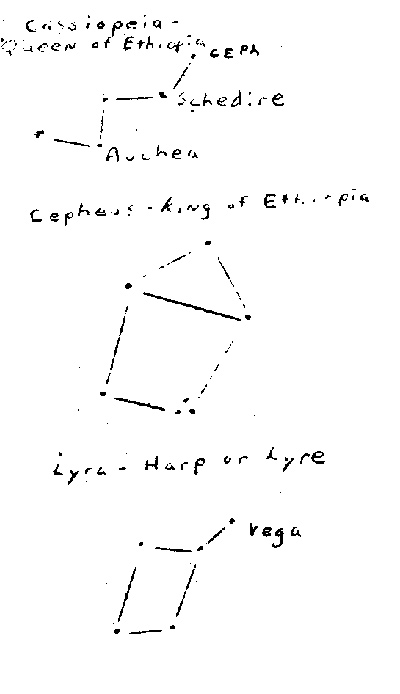 |
|
The constellation Cygnus is known as the swan or the
Northern Cross and contains two important - stars: Deneb and
Albireo. Deneb is a white, first magnitude star, 625 light years away.
Moreover, it is 10,000 times as luminous as our Sun.
On the other hand, Albireo is interesting because it
as an orange-red double star. According to legend Hercules once launched an
arrow (sagitta) toward Cygnus and Aquila (the Eagle) and missed. This goes to
prove what an utterly rotten shot Hercules was.
Bootes is known as the Herdsman, the Bear Driver, or the Plowman. In
Bootes, Arcturus is a first magnitude red-orange star which was used to open a world's fair in
the 1930's. A photometer was aligned with the star and opened the fair when Arcturus
reached a certain position in the sky. Moreover Arcturus is the 6th brightest star in the heavens and the 3rd brightest in the
Northern Hemisphere.
The constellation Canes Venatici is associated with the
Greek legends about Bootes. Canes Venatici represent the two hunting dogs of
Bootes which are yelping on the heels of Ursa Major, the Big Bear. This modern
constellation was discovered by the astronomer Hevelius and is made up of two
stars: Car and Carols (the Head of Charles).
If you strain your eyes, you can just barely make out the
faint, elongated constellation of Lynx just below Ursa Major. Supposedly while
Canes Venatici, the hunting dogs of Bootes, chase after Ursa Major, the Big
bear, Lynx scampers from under the Bear's paws.
|
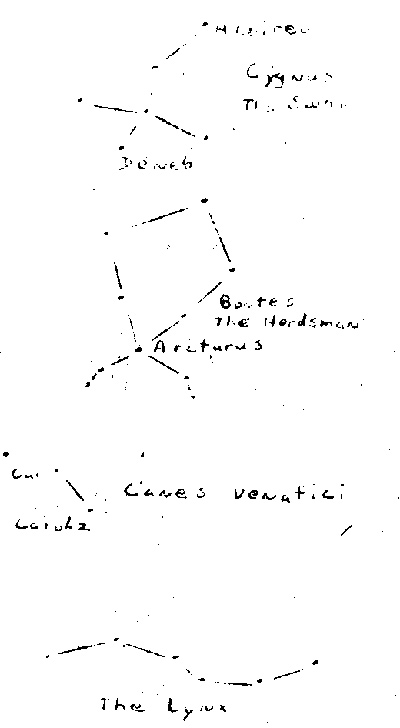 |
|
In Greek legend, Orion (the Giant or the Hunter) boasted
that he was the strongest man in the universe and that none could destroy him.
Zeus, hearing this foolish prattle, sent Scorpius (the Scorpion) to test Orion's
boast. Finally, Scorpius killed Orion by simply biting his heel, where he was
vulnerable. Moreover, Sagittarius (the Centaur archer), a close friend of Orion,
sought revenge and killed Scorpius with one of his arrows. All three were
eventually placed in the summer sky by the gods: Orion
in the winter sky and Sagittarius and Scorpius in the summer sky.
Sagittarius is a constellation shaped like
a small milk dipper and is found close to the horizon. In Scorpius the first magnitude
star Antares can be found easily. A red star, Antares is
sometimes mistaken for the planet Mars since they both have a reddish
color. However, there are differences between them. Star light is so faint that the
movements of the earth's upper atmosphere bend it and thus cause stars to
"twinkle." Because of their closeness to earth, planets reflected
light is so bright that the atmosphere can't entirely bend all of It.
Consequently planet light appears to be uniform and does not twinkle.
|
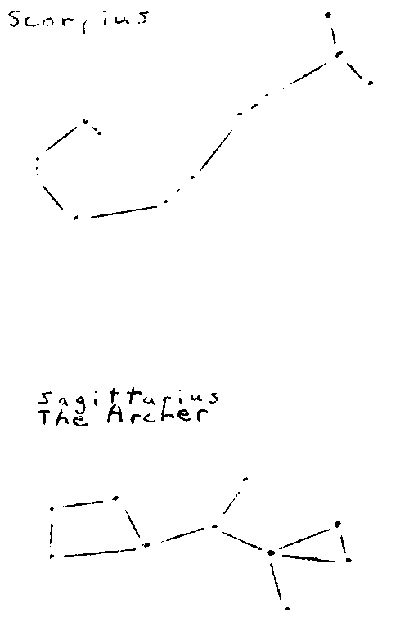 |
Circumpolar constellations are those which revolve around
the north star and are visible in our area all year round.
A star's Magnitude is a measure of its brightness.
A Light Year is an astronomical measure of distance,
almost 6,000, 000,000,000 miles.
Menzel, Donald, A Field Guide to the Stars and
Planet, Boston, Houghton Mifflin co., 1964. Peterson Field Guide.
Zim, Herbert, Stars, New York, Golden Press, 1956.
|





